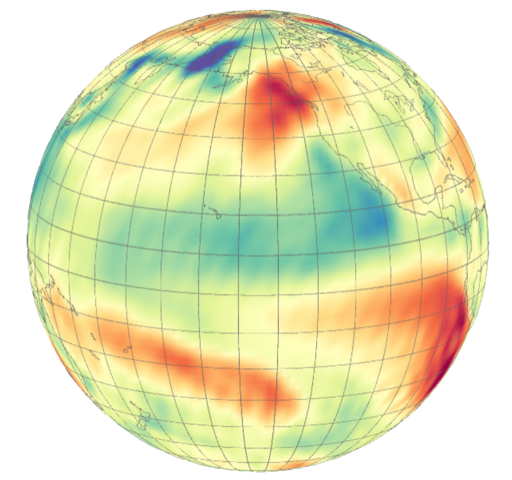-
The book is authored by Sam Shen with Jerry North, University Distinguished Professor Emeritus and former Head of the Department of Atmospheric Science at Texas A & M University.
PROFESSOR JOHN M. WALLACE, University of Washington, endorsed the book: 'This book is written by experts in the field, working on the frontiers of climate science. It enables instructors to “flip the classroom”, and highly motivated students to visualize and analyze their own data sets. The book clearly and succinctly summarizes the applicable statistical principles and formalisms and goes on to provide detailed tutorials on how to apply them, starting with very simple tasks and moving on to illustrate more advanced, state-of-the-art techniques. Having this book readily available should reduce the time required for advanced undergraduate and graduate students to achieve sufficient proficiency in research methodology to become productive scientists in their own right.'
August 31, 2023: SDSU Climate Informatics Lab receives a major NSF AI-Institute-Climate Science
research grant of $2.7M for four years.
This is a collaborative project with Distinguished Professor & Henry Samueli Endowed Chair Efi Foufoula-Georgiou (Co-Principal Investigator) at the University of California-Irvine and
Lloyd G. and Joyce Austin Presidential Professor Amy McGovern (Co-Principal Investigator) at Universiyt of Oklahoma. We are recruiting researchers of undergraduate students, MS students, Ph.D. students, and postdoctoral fellows. Please contact the project PI Sam Shen for research opportunities.
We particularly encourage URM researchers to join this project.
July 31, 2023: Sam Shen is a co-PI of a major California Climate Action grant
of $1.9M for two years.
The research is on the rural heat islands: Mapping and mitigating farmworker exposure to heat stress.
The project is a collaboration between San Diego State University, the University of California, Santa Barbara, University of California Cooperative Extension, and Lideres Campesinas.
July 31, 2019: Cambridge University Press publiushes a book authored by Sam Shen
Shen, S.S.P., and R.C.J. Somerville, 2019: Climate Mathematics: Theory and Applications, Cambridge University Press, Cambridge, United Kingdom, 391pp. The book website
www.climatemathematics.org has the R code, Python code,
datasets, all the figure files for the book, and other resources.
PROFESSOR KERRY A. EMANUEL, Massachusetts Institute of Technology, endorsed the book: 'Climate Mathematics is an engaging work that provides students of climate science with the most essential mathematical and computational tools of the trade. This may well prove the most useful text they will encounter on the road to becoming climate scientists.'
December 22, 2017: R Tutorial Product Release
This is a test version R Note tutorial
for the R codes in the book entitled "Climate Mathematics with R" by Samuel S.P. Shen and Richard C.J. Somerville.
May 19, 2016: Research Product Release: TWP-ICE 20-second Fractal PWV data
Twenty-second high-resolution precipitable water vapor
(PWV) data at Darwin, Australia during a 25-day period of 00:00 (UTC) January 20, 2006 to 24:00 (UTC)
February 13, 2006 are now available for download:
-
TWPICE PWV observed data csv file (2 MB)
-
1,000-day SDE simulated data csv file (30 MB)
The U.S. Department of Energy’s Atmospheric Radiation Measurement (ARM) program conducted a Tropical Warm Pool -
International Cloud Experiment (TWP-ICE) over 25 days from 20 January 2006 to 13 February 2006
in Darwin, Northern Australia. PWV was a TWP-ICE variable observed by a
2-channel ground based microwave radiometers (MWR). The ARM raw PWV data were supposed
to be at nominal 20-second resolution, although the real data’s resolution is fairly irregular.
This release is the PWV data in cm on a regular 20-sec time grid interpolated by Leung et al.
(2016) and Velado (2013). However, there are still many missing data, indicated by -1.
The 20-second high resolution PWV data have demonstrated fractal behavior
with Hausdorff dimension larger than 1.0. This non-differentiability property called for
modeling by stochastic differential equations (SDE) and Ito calculus, instead of
conventional partial differential equations (PDE) models following classical calculus.
This release thus includes a 1000-day SDE modeling output.
Users of this dataset should cite the following sources:
Leung, K., M. Velado, A. Subramanian, G.J. Zhang, R.C.J. Somerville, and S.S.P. Shen, 2016:
Simulation of high-resolution precipitable water data using a
stochastic differential equation with a random trigger, Advances in
Adaptive Data Analysis, vol. 8, 13pp.
Velado, M., 2013: A feasibility study of a probabilistic approach to analyzing cloud properties
such as floud fraction, liquid water path and precipitable water vapor, MS Thesis,
San Diego State University, 87pp.
Contact: Samuel Shen, Climate Informatics Lab, San Diego State University, Email: sam.shen@sdsu.edu, Tel: 619-594-6280.
March 4, 2016: Research Product Release: 2.5 deg Monthly Global Precipitation since 1901
Monthly 2.5 deg lat-lon resolution global (excluding the polar regions north of 75N and south of 75S)
precipitation data product: spectral optimal reconstruction of precipitation monthly (SOGPM1.0) from January 1901-December 2009. The data were reconstructed
by the method of spectral optimal gridding for precipitation version 1.0 (SOGP 1.0) by using EOFs generated by the 2.5 monthly GPCP data and regression on
the 2.5 deg gridded land station data of GPCC. SOGPM1.0 product data download: csv file (140 MB)
Users of this dataset should cite the following sources:
Shen, S.S.P., N. Tafolla, T.M. Smith, and P.A. Arkin, 2014: Multivariate regression reconstruction and its sampling error for the quasi-global annual precipitation from 1900-2011, J. Atmospheric Sciences, 71, 3250-3268.
Clarke, G.J., 2015: Hilbert-Huang Transform Applications and Computational Science Development for the Spectral Optimal
Gridding of Precipitation. Master of Science Thesis, San Diego State University, USA, 227pp.
Contact: Samuel Shen, Climate Informatics Lab, San Diego State University, Email: sam.shen@sdsu.edu, Tel: 619-594-6280.
December 29, 2015: Announcement of Important Applications of Climate Math Methods Developed by Sam Shen's group:
ECCA as a standard national climate prediction tool
US Climate Prediction Center's operational 3-month climate outlook.
The ensemble canonical correlation analysis (ECCA) method
was originally developed at NASA Goddard Space Flight Center by Samuel Shen, William Lau and their associates. The mathematical details are included in the
68-page NASA Technical Memorandum-2001-209989 by Shen et al. (2001). An application
example was presented in a Geophysical Research Letters paper by the same authors (Lau et al. (2002)).
The method was introduced to the US Climate Prediction Center by K.C. Mo. -
Global annual precipitation since 1900 reconstructed by spectral Optimal gridding for precipitation version 1.0 (SOGP 1.0).
The 5 deg annual (from July of the current year to June of next year) global (excluding the polar regions north of 75N and south of 75S)
precipitation dataset from 1900-2011 can be downloaded: csv file (2 MB)
A movie produced from the data can be downloaded: Precipitation History Movie (13 MB)
Users of this dataset should cite the following source:
Shen, S.S.P., N. Tafolla, T.M. Smith, and P.A. Arkin, 2014: Multivariate regression reconstruction and its sampling error for the quasi-global annual precipitation from 1900-2011, J. Atmospheric Sciences, 71, 3250-3268.
Contact: Samuel Shen, Climate Informatics Lab, San Diego State University, Email: sam.shen@sdsu.edu, Tel: 619-594-6280.
-
An Animation of Tibetan Plateau snow cover-daily version 1.0 (TPSC Daily 1.0): February 4, 1997 - March 15, 2012.
A movie produced from the data can be downloaded: Tibetan Plateau Daily Snow Cover Movie (1997-2012) (34 MB)
Users of this dataset should cite the following source:
Shen, S.S.P., R. Yao, J. Ngo, A.M. Basist, N. Thomas, and T. Yao, 2014: Characteristics of Tibetan Plateau snow cover variations based on daily data during 1997-2011, Theor. Appl. Climatol., doi: 10.1007/s00704-014-1185-0.
Contact: Samuel Shen, Climate Informatics Lab, San Diego State University, Email: sam.shen@sdsu.edu, Tel: 619-594-6280.
-
Canadian Applied and Industrial Mathematics Society awarded Sam Shen Arthur Beaumont Distinguished Service
Award for “his dedication, enthusiasm, involvement and vision as President of CAIMS from 2001-2003,
which helped develop the organization into what it is today.”
-
Nature made an official press release on Sam Shen and his student's work on Indonesia forest fires published in Nature-Geoscience. Many news media around the world, including New York Times, New Scientist, and Science Daily, followed the release and reported the research.
-
Alberta Agriculture, Food and Rural Development made a press release on Sam Shen's publication about the Alberta's agroclimate change from 1901 to 2002.
-
Sam Shen advises China on science policy. He is one of the ten overseas advisors to the Chinese Ministry of Science and Technology.
-
NASA Goddard Space Flight Center’s top story: New method greatly improves the US seasonal forecasts. This quasi-linear method was developed by William Lau, Samuel Shen and Kyu-Meong Kim.
Disclaimer:
We strive to use the best mathematical, statistical and computing tools to make our data products
as accurate as possible by strictly following scientific principles. The responsibility for the use and interpretation of our
climate data is entirely yours. We cannot be held responsible for your results derived from our data products
due to the nature and errors of our data nature.
This disclaimer applies to all the scientific products announced at this website.




